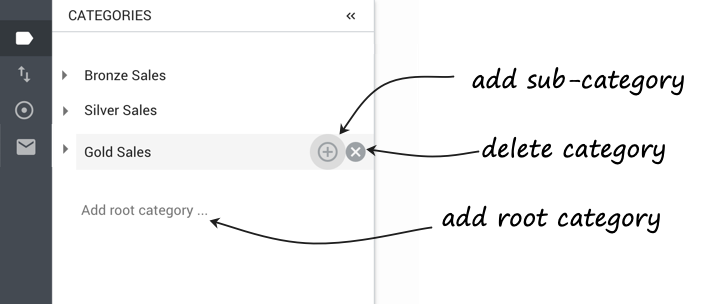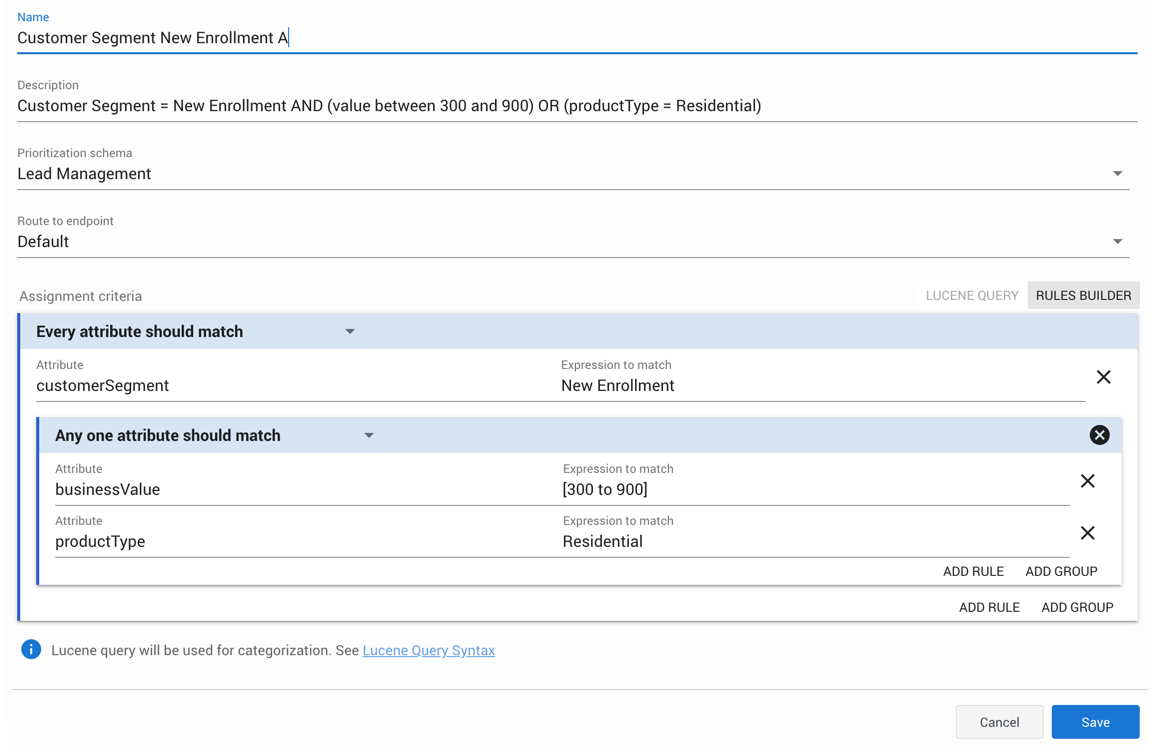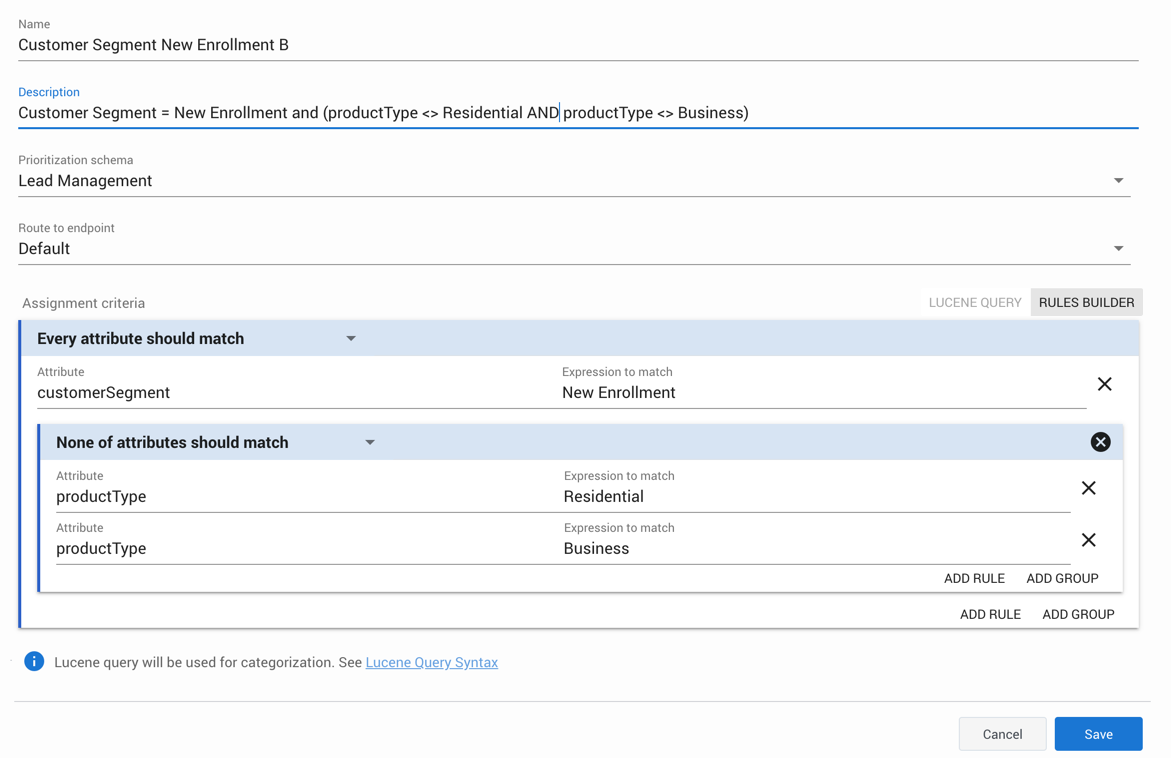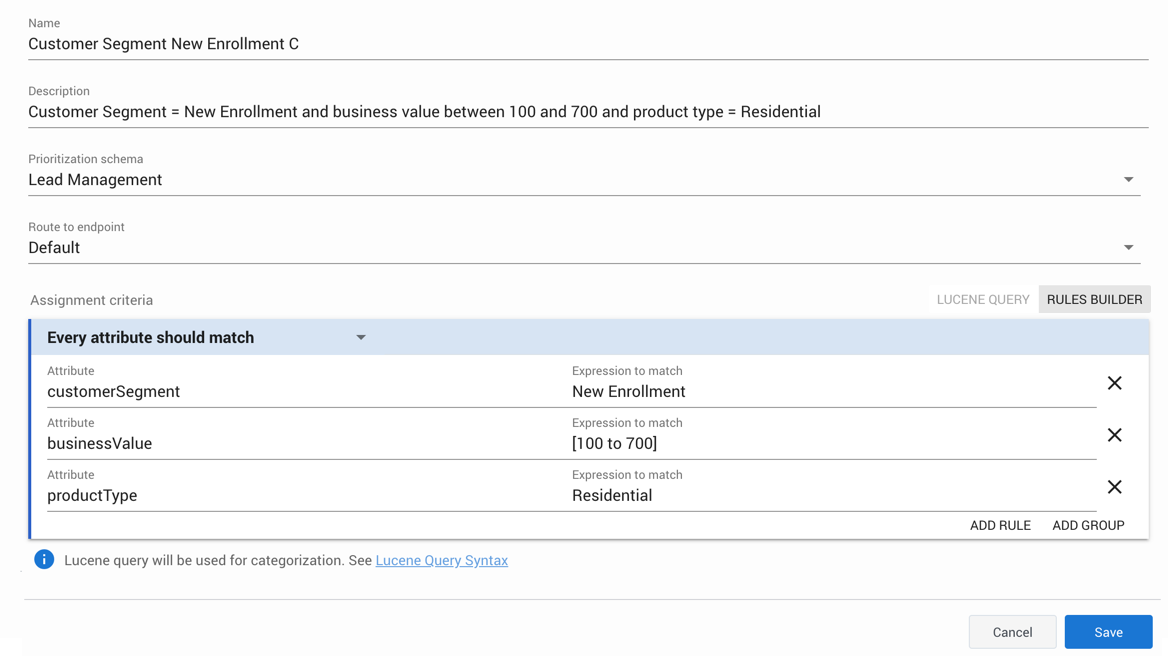View, edit, and create Categories and Rules
Contents
Work with the Categories that segment your work items, emails and leads ("work items") and the Rules that control how work items are processed.
View and edit a Category
On the Configuration tab, from the collapsible Categories panel, select the Category you want to view or edit.
The Prioritization schema and the Designer Endpoint associated with this Category are displayed. You can edit them if you have the appropriate privileges. Designer applications are loaded on the Designer Endpoint in order to match the segmented work items with employees.Category levels and reporting
The first level of Category (Service Department in the screenshot above) translates to the Department in historical reporting (for example, here).
The second level of Category (Gold Sales, Silver in the screenshot above) translates to the Process in historical reporting (for example, here).
The third level, and any lower levels, do not translate to historical reporting. These levels add power to the capabilities, but you should establish a clear business reason why you need to configure more than two levels.
The first level filters all work items that match the Category's criteria. Any sub-levels further filter work items that match the first-level criteria as well as the sub-level's criteria. In this way you can create a hierarchy that funnels work items through to lower levels of specificity so you can handle them in more specific ways.
Add/delete controls
- To add a new root category, at the bottom of the collapsible Categories panel, click Add root category...
- To add a sub-category to an existing category, click the + button to the right of the parent Category's name.
- To delete a Category click the X button to the right of the Category's name.
- WarningYou cannot undo deletion of a Category.
Create a new Category
- Select the Configuration tab.
- Open the collapsible Categories panel.
- Click either Add root category... or, to create a new sub-Category, the + symbol next to an existing Category .
- Give the new Category a name. For a sub-Category, enter a name that follows the naming convention for the root or parent Category, for example:
- [source system] [department][process] high-level criterion
- Give the Category a business-friendly description. Include the rule intention if possible (see the examples below).
- From the drop-down list, select a Prioritization schema for this Category.
- From the Route to Endpoint drop-down list, select a Designer Endpoint for this Category.
- In the Assignment criteria section, create a rule or group of rules, or a Lucene query, that will determine which work items IWD assigns to this Category. The examples below illustrate some relatively simple rules and rule groups.
- TipYou can use Elasticsearch query syntax in describing Categories and creating rules and rule groups.
- Click Save when you're done.
Rules
The Assignment criteria panel shows which rules and rule groups have been set up for this Category (with the RULES BUILDER button selected). Rules determine which work items are assigned to this Category. Rule groups are bundles of more than one rule. Rule groups can be coupled with standalone rules. (You can only nest rule groups down to the third level.) Every Category must have at least one rule configured. See the sample rules below.
Lucene queries
You can configure a Category by selecting the Lucene query option and entering Lucene query syntax in the field that displays:
Work items retrieved by the Lucene search will be assigned to this Category.
Rules examples
Example 1
This rule assigns work items to this Category if they meet the following conditions:
The value of their customerSegment attribute is New Enrollment
AND
EITHER
the value of their businessValue attribute is between 300 and 900
OR
Example 2
This rule assigns work items to this Category if they meet the following conditions:
The value of their customerSegment attribute is New Enrollment
AND
NEITHER
the value of their productType attribute is Residential
NOR
Example 3
This rule assigns work items to this Category if they meet the following conditions:
The value of their customerSegment attribute is New Enrollment
AND
the value of their businessValue attribute is between 100 and 700
AND
Configure a Category-level email auto-acknowledgement
ImportantAuto-acknowledgements configured at the mailbox level will negate any corresponding configurations at the Category level.Prerequisite
The content of auto-acknowledgement emails is created and stored in a Standard Response Library (SRL). To set up an SRL you need either eServices Manager or Designer, depending on your implementation.
Process
The process for setting up a Category-level auto-acknowledgement email is as follows:
- You create an IWD Category tree (for incoming email) that:
- Contains rules that segments email(s) into specific groups for a particular auto-acknowledgement.
- Is named indentically to the category tree path configured in the SRL that contains the required auto-acknowledgment content. Spelling and punctuation must match exactly. If there are any discrepancies, no auto-acknowledgement is sent.
- If a matching category path is found, IWD selects from that category the Active standard response that has usage marked for Acknowledgement.
If no match is found, or no standard response is configured in that category, no auto-acknowledgement email is generated.






